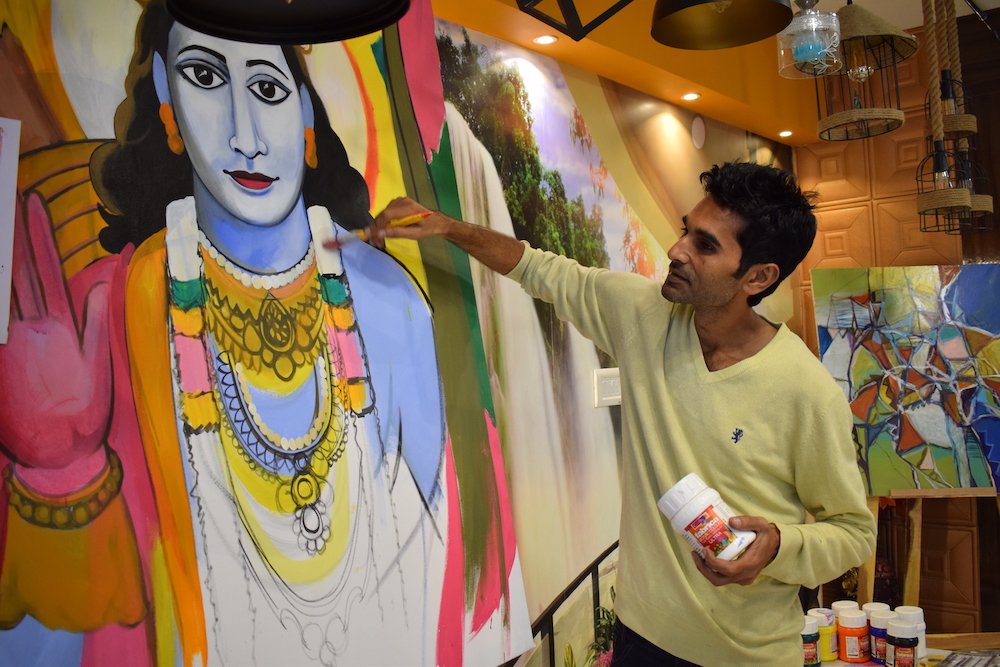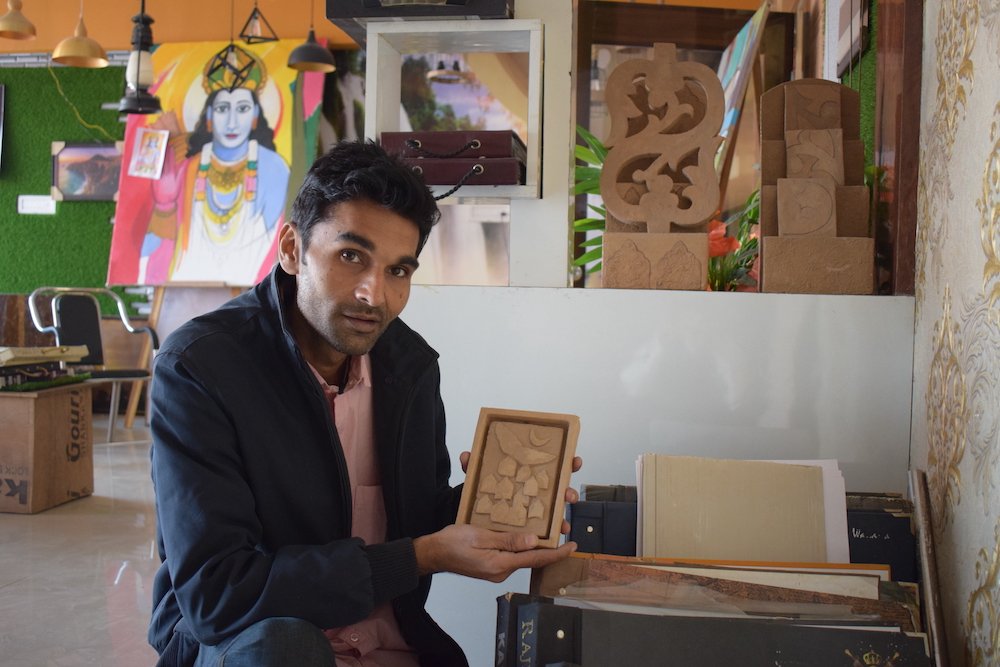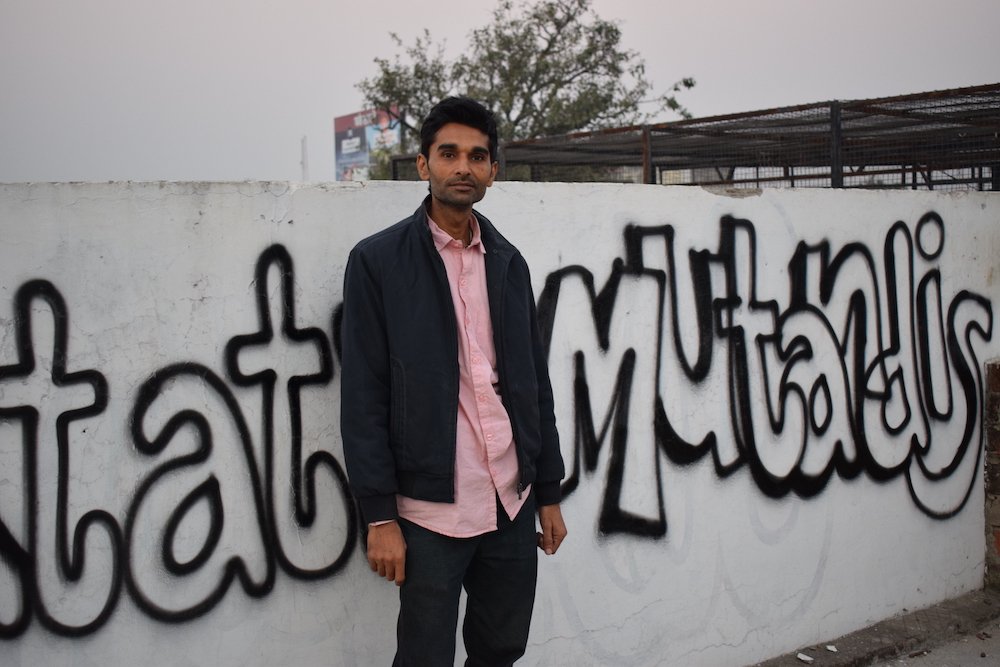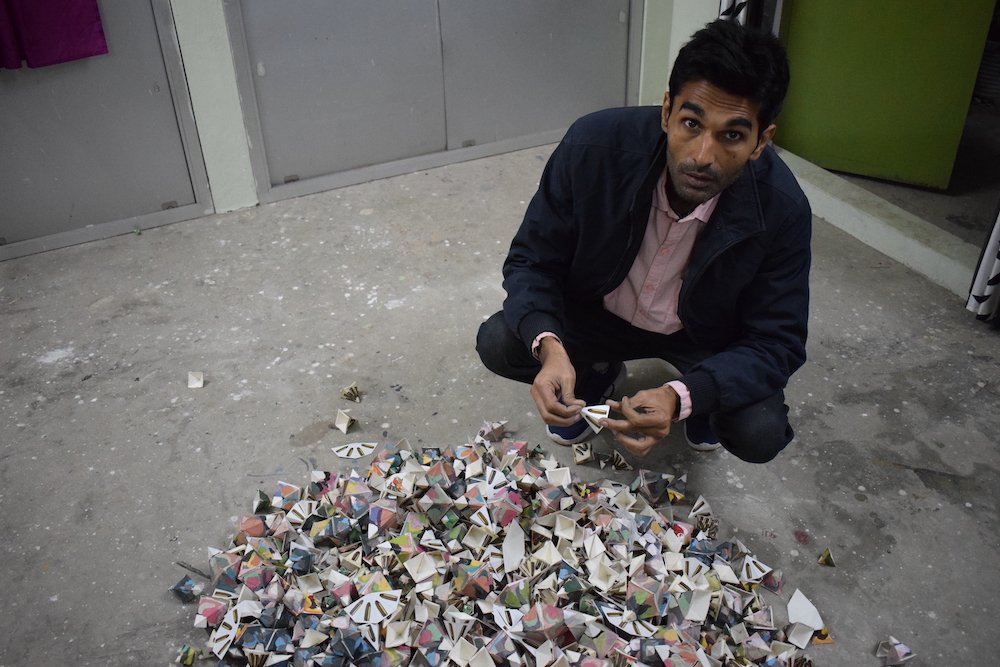Indian Muslim Artist Seeks To Reinvent Syncretic Spaces
Muslim artist Syed Ali Sarvat Jafri working on a portrait of Lord Rama at his studio in Faizabad. Photo by Priyadarshini Sen.
FAIZABAD, India— On the grey banks of the River Sarayu in Ayodhya, Syed Ali Sarvat Jafri plans to deliver the final blue and yellow touches to a life-size portrait of the Hindu deity Rama.
The 36-year-old Muslim artist lives only a few miles from the hypothesized birthplace of Rama in Ayodhya, the north Indian city that witnessed violent intercommunal rioting after Hindu nationalists tore down a 16th century mosque — the Babri Masjid — in 1992.
The dispute around Rama’s birthplace and the ensuing riots that killed more than 2,000 people in India not only scarred Jafri but also strengthened his resolve to have his art express a collective pain.
“I want to transcend the hate,” said Jafri, who descends from an ancestral tradition linked directly to the once-glamorous Awadh Kingdom of the 18th century — one of the most important states in the region after the break-up of the Mughal Empire. Jafri’s forefather was a renowned Unani physician — practicing a traditional Perso-Arab medicine based on the teachings of ancient Greek physicians — at the royal court of Nawab Asif-ud-Daula, renowned in Indian history for developing the distinct Muslim architecture of the city Lucknow.
Jafri’s ancestral home in Faizabad — a city dotted with Shiite mosques, gardens, arched gateways, souks and crumbling palaces from a bygone era — is seared with the memories of the destruction and violence that ripped apart Ayodhya-Faizabad’s syncretic society.
Like his ancestors, who imbibed elements of both Hinduism and Sufism in their literary pursuits as Shia poets, Jafri said he wants to integrate the sacred threads in his society. He also wants to spark conversations about history, memory and heritage preservation through art.
In November, Jafri started working on Lord Rama’s portrait outside a local art studio in Faizabad, where he works as a teacher and visual artist. That sunny afternoon, mats were laid out, a canvas was propped up on an easel and chairs were arranged for passersby. As the artist wielded his brush, a crowned deity came to life, a soft smile playing on his lips.
“We plan to carry (the) Lord Rama painting into Ayodhya’s riverfront, where many pilgrims gather,” said Shrikant, a Hindu artist who works with Jafri.
In a city where there are hardly any Muslim artists and where Hindu iconography dominates murals on buildings and shop fronts, Jafri’s bold brushstrokes caught people’s attention.
“At the heart of it all, people recognize the need for building religious harmony,” said Raju, a local artist who believes Jafri is the crucial link among the past, present and the future.
Some of the materials that Muslim artist Jafri works with at his home in Faizabad. Photo by Priyadarshini Sen.
Jafri shows a clay tablet he plans to recreate in his artworks in Faizabad. Photo by Priyadarshini Sen.
The past and the emerging political reality in India have haunted Jafri for a long time.
When the Babri Masjid was demolished in 1992, Jafri’s family took shelter in a safe house to escape violence that shook Faizabad’s Muslim-majority neighborhoods in particular.
Jafri — cradling his infant brother in his arms — reached the safe house, where the family huddled together for days as aggressors stalked the streets. Hindu nationalists were chanting inflammatory slogans and attacking homes, shops and places of worship.
“Those visuals were seared into my memory,” said the artist, who felt the impact of destruction over the years as the marginalization and stereotyping of Muslims escalated.
Amid this unbridled surge of majoritarianism, endorsement of the killing of Muslims became commonplace, and public displays of communal hatred were not unheard of.
In 2007, Jafri enrolled for a master’s in fine arts at the Banaras Hindu University in Varanasi, where he saw spaces for minorities shrink further. It was difficult for him to find accommodation as a Muslim student and even more difficult to witness attacks against minority faiths.
Jafri stands against a wall of graffiti advocating for change in Faizabad. Photo by Priyadarshini Sen.
Communalization had reached new heights in Varanasi after the murder of a neighboring town politician who belonged to Prime Minister Narendra Modi’s ruling Bharatiya Janata Party, often associated with Hindu interests. The growing intolerance and discrimination against people on the basis of their faith made Jafri question the relevance of religion.
But growing up in an observant Shia Muslim family, religion was the centerpiece of his life.
During Muharram — the first month of the Islamic calendar — Jafri would mourn the martyrdom of the grandson of the Islamic Prophet Muhammad and take part in other commemoration rituals: processional chanting and “zanjeer matam,” a gentle beating of the chest and head and wielding of swords to mourn the tragedy of Karbala.
The artist also read “namaaz” five times a day, recited poems of mourning at public squares in Faizabad, and learned Urdu and Arabic from a Muslim religious scholar at home.
“I wanted to become an Islamic religious leader,” recalled Jafri, who was taken in by the way the leaders would draw followers and the respect they commanded.
But Jafri’s exposure to the arts in Varanasi made him look at rituals more critically. The unprocessed trauma of destruction from his childhood came to haunt him during those years, and communal tensions in his hometown troubled him deeply.
In 2012, clashes between Hindus and Muslims broke out in Faizabad at the end of the 10-day Durga Puja Festival, when Hindu devotees were taking a Durga idol for immersion in a river nearby. The town was placed under curfew after rioters burned several shops and vehicles. Two people were killed in the ensuing riots and religious violence.
Memories of destruction came back to haunt him, so he immersed himself in art.
“I started crafting and painting hundreds of paper cones like tiny houses of worship,” he said. “I wanted them to bleed not the color red but different colors emblematic of peace.”
Jafri shows some of the paper cones he’s been working with in Faizabad. Photo by Priyadarshini Sen.
Photo by Priyadarshini Sen.
The next three years were spent “working breathlessly as though in a trance,” using the lexicon of the conflict: guns, bullets and roses. He wanted these motifs to channel his inner fears and uncertainties and speak about necessary changes for society. His canvas represented society’s brokenness.
“I wanted to change the surface metaphorically,” Jafri said. “The cones and other motifs talk about issues such as dual personality, hunger for power and human fragilities.”
Delhi-based artist Pratul Dash was drawn to Jafri’s use of earthy materials — like clay, cement and engineered wood — and materials used by subaltern groups. He said his works are not just aesthetically important but also relevant for their poetic narratives of resistance and stories and nostalgia.
The importance of the space Jafri occupies ties in to his work as a visual artist.
At home, he works with clay tablets, rickshaw rims and paper pyramids to recreate memories of a city that was once steeped in artistic practices, poetry and philosophy. At his studio, he tries to fuse Quranic teachings and Hindu philosophy.
The magnificent historical monuments in his city also find places in Jafri’s artwork. He spends hours sketching ideas amid their arched facades adorned by minarets or at their central chambers crowned by inverted lotuses. At night, he ventures out to catch their shade, remembering stories handed down to him about the city’s rich past.
“I want my art to serve as a historical registry of syncretic spaces that may be erased due to religious hostilities,” Jafri said. “It’s a call to preserve our heritage and collective future.”
Jafri’s unique standing at the crossroads of history has caught the attention of art critics in India and abroad. In 2020, he was nominated for the Jameel Prize — an international award for contemporary art and design inspired by Islamic tradition — and an international art residency in Amsterdam, where philosophers, academics and artists meet to exchange ideas.
“His art marked me the most on my trip to India,” said Jihan El-Tahri, a French-Egyptian writer, director and producer of documentary films. “There’s an internal space from where Syed makes his art.”
In Mumbai, where Jafri had his first solo exhibition in 2019, his leitmotifs sought to transform blood into flowers and violence into beauty. He felt he could finally articulate the uncertainties, protests and stifled cries of religious minorities before a public audience.
But the attention Jafri has garnered outside is not often received so positively back home.
Last year, when he approached the district administration about a graffiti and mural project in Faizabad’s public square, he didn’t get the backing he was hoping for.
“That’s why we’ll start by painting Lord Rama at the riverfront,” said Shrikant. He believes breaking old patterns won’t be easy in a place that’s witnessed such a difficult past.
Jafri calls it “Mutatis Mutandis,” necessary alteration to usher positive change.
Priyadarshini Sen is an independent journalist based in Delhi. She writes for Indian and U.S. media. Follow her on Twitter @PriyadarshiniS_






